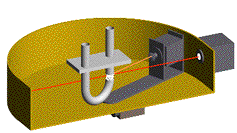RESEARCH INTERESTS Dr. Hull has been involved in a variety of research projects during her years at TSU. Early in her career, she worked in the area of solar energy and holds a patent on a solar engine. During the last ten years, however, much of her research has been in characterizing microscopic materials using polarized light scattering. The focus of that work is threefold:
The Scanning
Polarization-modulated Nephelometer Dr. Hull's research in polarized light scattering began in 1990 when she received a grant from the Office of Naval Research to evaluate analytical models for light scattering from cylindrically- shaped microscopic objects. Over the next four years, the analytical work was broadened to include modeling light scattering from particles of all shapes. To date, she has instrumental in developing numerical models for describing polarized light scattering from a number of particle shapes such as coated spheres, ellipsoids, helices, cylinders, and fractals. In 1994, an experimental
component was added to the research effort in polarized
light scattering. A Laser Optics Laboratory was
opened using an equipment grant from the Department
The third component of
research in polarized light scattering funded by ONR, the
design and testing of artificial neural networks
for interpreting light scattering data, was added in
1996. Dr. Hull has designed neural networks that
have been successful in extracting particle size
distributions, effective relative index of refraction,
and absorption coefficient, from polarized light
scattering data. Both analytical and experimental data
are used to train and test the artificial neural
networks. The results of the work in neural networks was
presented at Ocean Optics Conferences |
